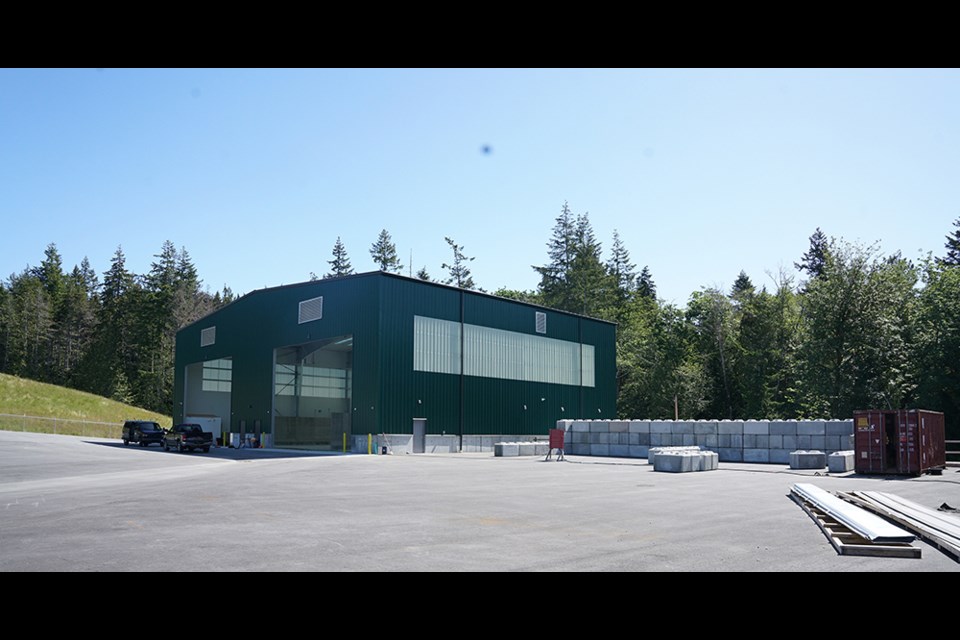qathet Regional District’s (qRD) resource-recovery centre is edging nearer to completion, providing a well-designed facility that is planned to be as green as possible in its natural, forest-like setting.
Arnold Schwabe, qRD manager of asset management and strategic initiatives said construction has gone well. He added that there have been some issues with delays, suppliers and procuring everything required for the project.
“We might be a month or two past our original hope for opening but we are still expected to be open this summer,” said Schwabe.
The first priority is the opening of the transfer station, where compostable and solid waste will be dropped off and processed for transporting out of the region.
“That will be commercial traffic,” said Schwabe. “It will be municipal solid waste trucks and organic curbside trucks. We’re hoping to have that open first.
“Once we have that open, we’ll be working on our EPR (extended producer responsibility) building, from which we will be primarily recycling. After we open the transfer station and the EPR, we will be bringing in residential waste into the main transfer station.”
Jason Kouwenhoven, manager of environmental services, said one of the next major hurdles for opening the transfer station will be getting scales installed to weigh vehicles. There is also some paving to complete in the facility, the big roll-up doors need to be installed in the commercial transfer station, work is being done on finishing some building exteriors, and some work is scheduled for installing railings and safety barriers at the site.
Great attention has been paid to maintaining green space at the resource-recovery centre and making sure it is not just an industrial zone. Kouwenhoven said the commitment goes back to the solid waste management plan the regional district adopted in 2017, supported by the regional district board, City of Powell River Council and Tla’amin Nation.
“The solid waste management plan included a resource-recovery centre plan and part of that was to really pursue all these green elements, such as reusing materials found onsite,” said Kouwenhoven. “We have reused materials for fill in our concrete and asphalt work. We have reused wood from trees that have come down at the site for wood accents. There is a real emphasis on getting passive lighting in our facilities, installing heat pumps and pursuing low energy usage, such as LED lighting. All those things were very important right from the get-go.
“In that solid waste management plan, we weren’t just building an industrial site, we’re building a community facility – something that blurs the line between an industrial setting and nature, and that fits in with the theme of community on this beautiful coast.”
Schwabe said the goal was to clean up the entire site and leave it in a much better state than when the project began.
Green space
While the actual resource-recovery centre is fenced off, there is considerable green space around the facility, with spring-fed ponds that are attracting wildlife. There are trails, and even a space that can be used as an outdoor theatre for events such as PRISMA (Pacific Region International Summer Music Association). There is also space for education to take place, and the old incinerator still stands as a reminder of how far waste management has come in qathet.
In anticipation of the opening of the centre, Kouwenhoven said staff members are being hired and will be trained. He said the new facility will be efficient.
“The point of this facility is to find that efficiency,” said Kouwenhoven.
When asked if this will be a state-of-the-art facility, Schwabe said the qathet facility is definitely not behind anywhere else in terms of its operational capability. He said the scale system will be state of the art and involves the newest technology available.
“We will have automation in our scale house,” said Schwabe. “Other places will be using items such as electric vehicles and electric equipment. We will be doing our best with technology. We are doing our best to use the best equipment we can at a reasonable cost.”
Planning process
Kouwenhoven said in addition to procuring the items required to make the resource-recovery centre work, operational planning is underway, as well as emergency planning.
“We are bringing in various other organizations to give us advice,” said Kouwenhoven. “We’re really trying to get ahead of as much as we can anticipate and that we’ve experienced at other facilities in the area. We’re going to continue working and making sure that what we set up for this site is efficient for us, and efficient for the users of this site, including residential users, commercial users, businesses and the other local governments.
“We don’t want to reinvent the wheel so we are borrowing all the advice and knowledge and wisdom we can get from local contractors and operators, as well as our neighbouring regional districts and municipalities.”
Kouwenhoven said the design of the centre will make it more convenient for users. The design will also provide for maximum diversion of materials so the least possible amount of material is being shipped to the landfill in Washington State, which is better for the environment and more cost-effective.
“Every one per cent we can take out of solid waste is thousands of dollars every year,” said Schwabe. “We’ll take the small wins. If it’s two per cent or three or five per cent that we can divert, it’s thousands of dollars that our taxpayers aren’t paying to ship to Washington.”
Local pilot Tye Leishman took several aerial photos of the resource-recovery centre during a flyover earlier this month.
Join the Peak's email list for the top headlines right in your inbox Monday to Friday.



